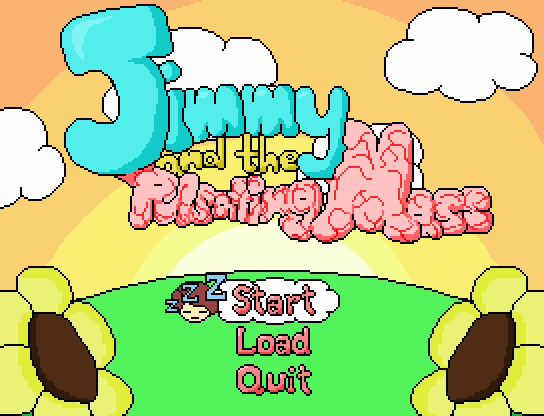
This article marks the beginning of a new section on Indie Overlook because I’ll be covering a demo for a game still in development. Like with the extra articles and those for player-created content, the structure and general length of this segment is probably going to change over time. To properly inaugurate this section, today’s article will be covering the demo for an RPG I have been looking forward to since it was first announced – Jimmy and the Pulsating Mass.
If the disturbingly organic and literally pulsating “Pulsating Mass” latched on to the colorful and cartoony word “Jimmy” in the title screen somehow wasn’t enough of a warning, the first minute of gameplay should be more than enough to tip you off to the fact that this isn’t going to be the mindlessly pleasant and entirely happy-go-lucky game which it might come off as from screenshots. Between the opening containing some ominously distorted black and white not-quite-static and a song which includes the lyrics “Open your eyes / It’s too early to say goodnight” it’s looking like Jimmy and the Pulsating Mass will almost certainly fall into the same category as Mother 3 and Undertale (not to mention The Heart Pumps Clay, a much shorter game also made by Housekeeping): funny and wacky and weird until it decides to turn on a dime and make players cry their eyes out in front of their monitors. Future speculations aside, this demo starts at the beginning of the game, has enough content to last for about two hours, and for the most part it works very well.
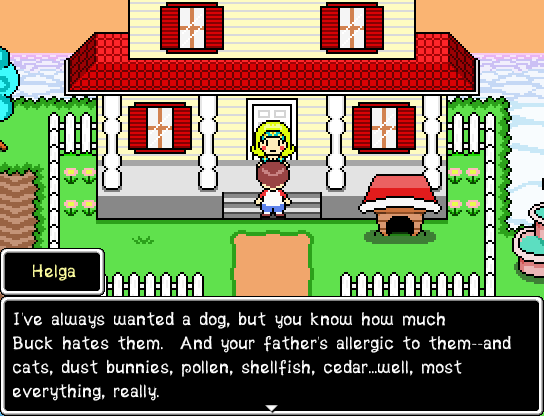
Jimmy is our protagonist and he seems like a remarkably normal eight year old boy, at least at first, but the world he inhabits is far from ordinary. Jimmy lives with his older brother, his mom, his dad, and his lazy uncle at a house near some hills. His first task in the game is to help Buck, his brother, clean up his messy room in exchange for Buck coming with him to get honey for a cake and this latter task is what most of the time in the demo is spent on. Of course, the you can climb up vines to walk along the tops of the clouds near Jimmy’s house, enormous crystals grow on top of some of these clouds, the nearby town is full of animal people, and mysterious group of ‘low-level goons’ are dead set on preventing Jimmy from leaving his house. Oh, and cleaning Buck’s room consists of defeating a living pile of slime and garbage and doing so results in Jimmy being able to transform into said pile of slime because of how empathetic he is. Dreams and imagination are going to play a large role in the full game to the point that there will be ‘nightmare’ dungeons and I think the small portion shown in the demo does a great job of introducing players to the dreamlike quality of the world by juxtaposing a relatively ordinary family and simple tasks like cleaning a room or going out to get cooking ingredients alongside increasingly bizarre places and events.
Before diving too much further into the plot let’s take a moment to look at the combat and encounter systems. Fights are random, fairly frequent (though not obnoxiously so), and are triggered by an exclamation point appearing over Jimmy’s head. The catch here is that this exclamation point can be red or green and green fights can be ignored at the push of a button; fights far below the party’s level will always appear as optional green exclamation points while fights at around the same level as the party still appear as green about a third of the time, so you don’t need to be worried about being forced to fight every single enemy that comes your way even on your first time in a new area unless you are significantly underleveled. I generally prefer encounter systems where enemies are visible on the map, but the present system is likely for the best in this case because the game incentivizes backtracking to discover new parts of old areas and being able to completely ignore weaker enemies saves a lot of time.
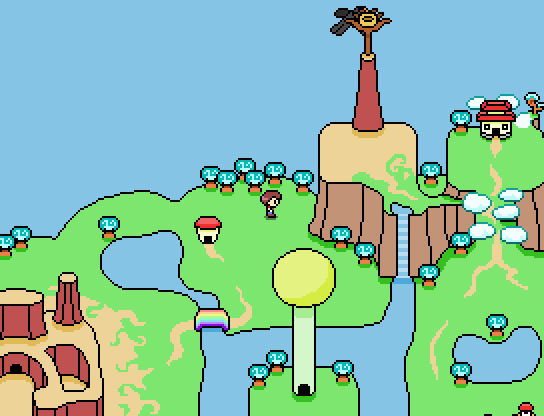
The combat system itself is a standard turn-based affair, but with a few extremely important mechanics mixed in to change things up. The largest of these mechanics by a landslide is the empathy system. After certain plot-specific fights, such as the fight against the slime in Buck’s room, Jimmy is able to empathize with his defeated foe to such a degree that he gains the ability to transform into it. These transformations all open up new ways to interact with the world and its inhabitants outside of combat (ex: Jimmy can squeeze through small openings as a slime), but each transformation also comes with its own set of skills to use in combat. In addition to the defensive and debuffing skills granted by the slime, Jimmy gains access to an offense and support-oriented low-level goon transformation and a flower transformation which grants him a magic attack and some healing capabilities within the span of the demo. Each transformation comes with four active skills as well as various passives and stat modifies; transformations only level up while you’re using them and their levels are separate from Jimmy’s character level. One of the biggest aspects of the empathy system, and one which sadly doesn’t get much use by the end of the demo, is the ability to place the skills from each transformation into shared skill slots once the transformation hits certain level milestones so you can mix and match skills rather extensively later on.
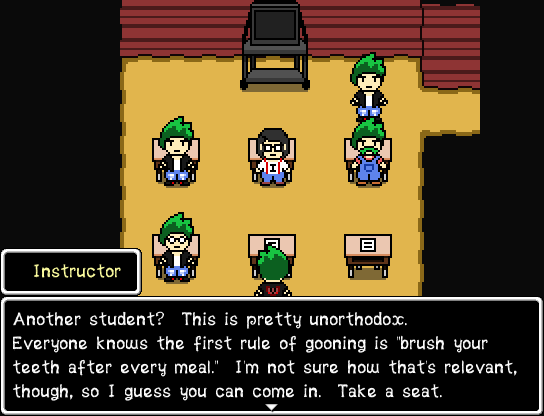
The existence of the empathy system is far from the only notable part of the combat though. In case you were worried about running into an enemy Jimmy’s current transformation is ill-equipped to deal with, Jimmy can perform a transformation in combat without using up his turn, though there is a two turn cooldown between transformations to prevent players from constantly having access to every skill since that would largely defeat the purpose of the skill slots. Turn order and support skills are both put in the spotlight this time around and even random encounters can cause a lot of trouble if you play carelessly. Though Buck is capable of dishing out plenty of damage, his most useful skill is almost certainly Insult, which stuns an enemy for a single turn. Enemies gain the Alert status on the turn after they are stunned so you can only ever keep an enemy stunned 50% of the time, but this same anti-stun benefit applies to your party members as well. I generally view Agility is the least important stat when there isn’t some form of an ATB system in place, yet Jimmy and the Pulsating Mass has managed to make this stat, and skills and equipment which modify it, vital as you race to keep the most troublesome enemies locked down before they can do the same to you. The value of stuns is further increased once enemies with grabbing abilities start to show up as a grabbed party member skips their turn while taking a pretty nasty amount of damage and the only reliable ways I’ve found of forcing an enemy to let go are to outright kill it or stun it. The Grift ability, which Jimmy can use in his goon transformation, is yet another important skill because it allows Jimmy to steal in combat. Though several enemies have useful items to steal, such as furniture which you can place in a house for passive bonuses, the real appeal of this skill is the extent of what it can do in combat, such as stealing a bone from a skeletal enemy to make it collapse on the spot or, when confronted with a duo of turtles stacked together, ‘stealing’ the bottom turtle from the stack to separate them and knock the top turtle on its back. Add in a good number of status ailments, buffs, debuffs, and enemy behavioral quirks to keep track of over the relatively short course of the demo and you soon learn to be wary of every new enemy you encounter because this game isn’t pulling any punches as far as difficulty is concerned.

As enjoyable as the combat is, the writing is what steals the show. If Lisa was referred to by some as ‘Earthbound for adults’, then Jimmy and the Pulsating Mass falls somewhere in-between with a little bit of blood, a drug reference or two, and some very light innuendo, but there is nothing overly explicit or graphically disturbing, at least not within the confines of the demo. Though the world is filled with silly characters and plenty of quirky humor, the tone is capable of abruptly becoming much darker for brief moments and an underlying sense of unpleasantness is occasionally present within the humor itself. These darker moments are made all the more effective by the fact that they aren’t created by some great evil or catastrophic events, but rather by an all-too-common lack of empathy. Though there is plenty of foreshadowing concerning a mysterious and seemingly coldhearted figure who will likely serve as a main antagonist in the full game, the most disturbing lines of dialogue often came from the most seemingly lighthearted characters. Mr. Marvelous, a frog in a top hat who goes around building exaggerated statues of himself everywhere, makes for a good example because the whimsically optimistic spin he puts on any given situation is charming and funny, but many of his lines of dialogue also reveal a dangerous lack of care for the consequences of his actions and a not-so-funny sense of belittlement towards others caused by his cartoonish superiority complex.
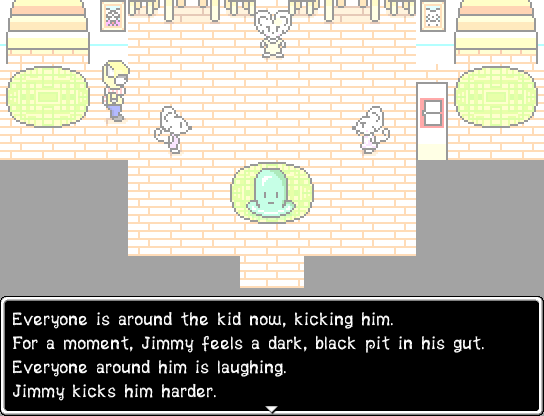
Empathy, and the lack thereof, is a main and frequently recurring theme all throughout the demo, which isn’t at all surprising in a game where empathy is the defining trait of its protagonist. The trials Jimmy must overcome and the foes he has to face aren’t the result of something nebulous like darkness or evil, they are the result of much more grounded reasons, such as petty cruelty and selfishness. Though plenty of characters have larger-than-life personalities, the demo does a great job of evading the trap of sorting its cast into good guys and bad guys; even the antagonists sometimes display brief glimpses of compassion and not every member of the nearby town of Smile is completely devoid of cruelty no matter how bright and colorful the setting may be. My favorite parts of the demo occur when Jimmy gains a new transformation because Jimmy imagines himself as being in the shoes of his defeated foe and these are the only glimpses we get into the mind of our otherwise silent protagonist. Interestingly, all three of these empathetic moments start off happily before taking a darker turn where things end poorly, such as in the case of the low-level goon where Jimmy imagines himself having reckless fun with his gang of friends until they come across a kid who “looks a lot like Jimmy” and peer pressure leads to him beating up the kid despite a brief moment of self-loathing. Like with the setting, the writing is ultimately made far more effective by its willingness to combine cartoonish quirkiness and weirdness with elements more firmly grounded in the realm of cold, hard reality.

There is a lot of aesthetic polish here and this is another area where the comparison to the Earthbound series, and especially Mother 3, is virtually inevitable. Every asset here, including the music and possibly at least a few of the sound effects, has been made specifically for this game. Though the artstyles are similar, the Mother 3 comparison has more to do with the amount of effort that has gone in to using sprite animations to make every moment count. Characters don’t just stand around or rely on a handful of stock reactionary sprites during cutscenes, they make small gestures and other unique animations which really bring them to life. The art also goes a long way towards helping to shape the world with its darker elements hidden within its cheerful veneer, such as in a location known as Giant Garden where you walk through fields of enormous vegetables, but one part of it contains patches of lettuce with eerie, unblinking eyes and continuing through this patch takes you to an abandoned mine where your field of vision shrinks the farther in you go. All of this visual polish is also equally by the music, which always matches the atmosphere no matter how dark or cheerful it may be and has a distinctive sound created by the frequent use of distorted or unusual ‘instruments’, such as clapping or the sound of a typewriter.
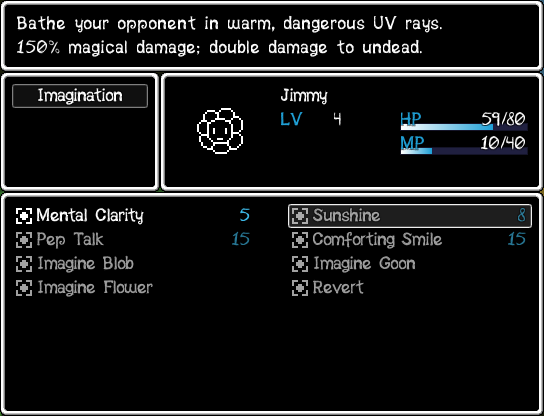
While this is a great demo in many ways, it is not without a few issues. Two of the three major areas in the demo, Cloudy Hill and Giant Garden, contain some lag while you’re walking around in them, especially the former. There is also currently a game-crashing glitch which occurs when you try to interact with some NPC’s while Jimmy has a green exclamation point over his head. Text also moves a bit too quickly in combat and it can be difficult to read the unique flavor text which accompanies virtually every action performed by any given enemy. On the less technical side of things, one point where the writing in the demo is weaker than usual is in the case of Buck whom, despite accompanying Jimmy from almost the very start of the game, may as well not exist after he joins the party as far as the narrative is concerned; friends and foes alike speak exclusively to Jimmy and I cannot recall Buck doing or saying anything after leaving the house. Perhaps there is an underlying reason for this which gets revealed within the full game, but Buck’s lack of a narrative presence definitely feels off within the confines of the demo. A final issue, though one which falls into more of a grey area, is the lack of flavor text in the environment. This is a deliberate decision to focus showing instead of telling on the developer’s part and, to be clear, there are plenty of NPC’s to interact with and even the most inconsequential of items and abilities come with flavorful descriptions so the world is far from empty. However, while I think this “show don’t tell” approach largely works here and many of the stranger sights are more effective as mysteries, the complete lack of environmental interaction with most objects in the game makes it very easy to miss the few unusual objects which can be interacted with, such as in the case of one interactive object which reveals an entire optional dungeon. I’m by no means saying that Jimmy should be able to interact with every lamp, jar, and barricaded door, but the inclusion of a few more environmental interactions, even if they are completely frivolous, could serve as reminders to players to thoroughly explore their environments.

Despite a few mostly minor issues, this demo hits all the right notes. It’s long enough to serve as a proper introduction to the setting, the atmosphere, and the combat system without overstaying its welcome. It also manages to pack in a decent amount of side content and it ends on a wonderful narrative cliffhanger. Most importantly, it left me wanting more and, since demos ultimately serve to sell players on the full games, I’d consider this a job well done.